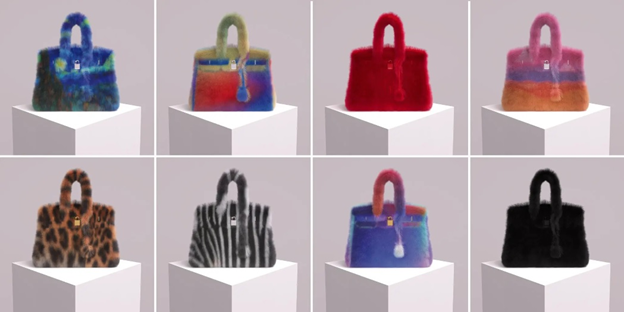The New York Times
The verdict means First Amendment protections did not apply to a digital project blurring the line between art and business.
Eight examples of MetaBirkins, the NFTs that Mason Rothschild sold online for $450 apiece.Credit…via Mason Rothschild
Perturbed when an artist made a digital version of its coveted Birkin handbag with a reproduction of a mature fetus inside it, the luxury fashion brand Hermès watched in shock as other iterations popped up online. A Birkin with mammoth tusks affixed to it. One sporting the Grinch’s shaggy green fur. Others stamped with van Gogh’s “Starry Night” or populated by smiley emojis.
Hermès swiftly sued the artist, Mason Rothschild, over the NFT project he called “MetaBirkins,” arguing that the company’s trademark was being diluted and that potential consumers might be fooled into buying the unaffiliated virtual goods.
The case’s ramifications extended far beyond Hermès. In some of the first litigation to scrutinize the nature of digital assets sold on the blockchain, up for debate was whether NFTs, or nonfungible tokens, are strictly commodities or art shielded by the First Amendment.
On Wednesday, a nine-person federal jury in Manhattan determined that Rothschild had infringed on the company’s trademark rights and awarded Hermès $133,000 in total damages. The jurors also found that his NFTs were not protected speech.
Rothschild’s defeat was a major blow for the NFT market, which has often described itself as part of the creator economy. But the jury determined that MetaBirkins were more similar to commodities, which are subject to strict trademark laws that prevent copycats, than to artworks where appropriation is protected.
In a statement after the verdict, Hermès said it was compelled to act to protect consumers and the integrity of its brand. “Hermès is a house of creation, craftsmanship and authenticity which has supported artists and freedom of expression since its founding,” it said.
One of Rothschild’s lawyers, Rhett Millsaps II, called it a “great day for big brands” and a “terrible day for artists and the First Amendment.”
Rothschild criticized the jury, the justice system and a luxury fashion house that he said was emboldened to determine who qualified as an artist.
“What happened today was wrong,” he said in a statement. “What happened today will continue to happen if we don’t continue to fight.”
The verdict could provide some guidance for brand owners, said Megan Noh, an art lawyer unaffiliated with the case, “about the line between works of artistic expression and commercial goods.”
Birkin bags, named after the actress Jane Birkin, are made by hand and take specialized artisans a minimum of 18 hours to make. Hermès does not disclose how many of the bags it has made since they were first created in 1984, but some researchers of luxury goods have estimated that there are now more than a million Birkins in the market. In 2021, the auction house Sotheby’s sold a Birkin for more than $226,000.
Rothschild had plans to create 1,000 MetaBirkins, which he has described as an “ironic nod” to the renowned brand, but only 100 have been released since the project began in 2021.
Each was priced at $450, and Rothschild also received 7.5 percent of secondary sales. Hermès has claimed in court filings that MetaBirkins reached about $1.1 million in total sales volume. Rothschild has estimated that he made about $125,000 from the NFTs, including the initial sales and royalties.
“What we see in the Hermès case is how emerging technologies and historic, age-old brands collide,” said Ari Redbord, head of legal and government affairs at TRM Labs, a blockchain analytics firm.
Over the past decade, the French company’s Birkin collection has steadily generated $100 million in sales each year. In recorded testimony played during the trial, Robert Chavez, president and chief executive of Hermès of Paris, said he was not aware of any revenue that the company lost because of MetaBirkins.
During opening arguments in the U.S. District Court for the Southern District of New York, Oren Warshavsky, a lawyer representing Hermès, argued that MetaBirkins confused consumers who thought they were connected to the fashion brand.
“The reason for these sales was the Birkin name,” he said.
Rothschild’s legal team questioned whether people wealthy enough to afford Birkins, which cost thousands of dollars and often have yearslong wait lists, would be genuinely misled by his art project.
Millsaps also argued that the NFTs were art that was protected under the First Amendment as free speech. The lawyer said Birkins were a “cultural symbol of rarefied wealth and status,” ripe for artists to explore as metaphors of consumerism.
“Art doesn’t exist in a vacuum — it’s often about context,” he said.
Blockchain assets like MetaBirkins were part of the financial boom-and-bust cycle in cryptocurrencies over the past few years. At the market’s height there was a $40 billion industry around digital collectibles, but fortunes eroded last year as the volume of NFT sales fell by 97 percent.
Yet lawsuits are still playing out across the beleaguered industry, including trademark fights focused not on the technology itself, but the essence of what users have stored on the blockchain.
Yuga Labs, the creator of the NFT franchise Bored Ape Yacht Club, has filed a trademark infringement lawsuit against the artist Ryder Ripps, accusing him of copying its imagery. (Ripps has said the lawsuit attacks his free speech rights.) The company announced on Monday that it had settled a separate case against Thomas Lehman, a developer on Ripps’s NFT project, who admitted to infringing on the Yuga Labs brand.
Noh said the best protection artists have against trademark disputes is the Rogers test, a legal standard established in 1989.
In that case, the actor Ginger Rogers had sued the movie producer Alberto Grimaldi, arguing that the film “Ginger and Fred” violated her trademark rights because it used her name in connection with its fictionalized depiction of a pair of washed-up Italian dancers. But a federal appeals court determined that the use of the name Ginger was an expressive element of the title, artistically relevant to the underlying film, and therefore subject to First Amendment interests that needed to be weighed against the risk of misleading consumers.
Rebecca Tushnet, a Harvard Law School professor who helped prepare Rothschild’s defense, said the Rogers test meant “you can’t hold someone liable for infringement unless their work is artistically irrelevant or explicitly misleading.”
During the trial’s opening arguments, Hermès attempted to minimize Rothschild’s credibility and artistic intent by focusing on his business strategy, displaying text messages in which he asked social media influencers to “do one more shill post” that might raise demand for his NFTs. The company’s lawyer also told the jury that Rothschild had publicized its cease-and-desist letter on social media, hoping that conflict might drive interest.
Judge Jed S. Rakoff granted Hermès’s motion to exclude a report prepared by the art critic Blake Gopnik that favorably compared the MetaBirkins to artwork by Andy Warhol and Damien Hirst. (Gopnik contributes to The New York Times.)
The defense painted a more sympathetic picture of Rothschild, 28, who worked in retail for streetwear brands and luxury brands like Saint Laurent after dropping out of college. In 2021, he and Ericka del Rosario, now his fiancée, opened a concept store in Los Angeles called Terminal 27. He often hired assistants with the technical skills he lacked to work on projects, including MetaBirkins.
Rothschild was “a conceptual artist,” Millsaps, his lawyer, said. “The idea guy, not the guy who executes the job.”
The strength of trademark rights will soon be tested again when a case between Jack Daniels and VIP Products, which sold squeaky dog toys resembling the whiskey maker’s bottles, goes in front of the Supreme Court.
Some veterans of the fashion industry wondered why Hermès had bothered litigating the case at all. Although Chavez testified that the company had been experimenting with its own NFTs, including a project intended for release this year, it has let other unsanctioned projects slide, like when the Brooklyn collective MSCHF turned the Birkin bag into $76,000 “Birkinstocks.”
Ian Rogers, the former chief digital officer of the fashion conglomerate LVMH, who currently works at a crypto company named Ledger, said the company’s preoccupation with Rothschild was puzzling.
“Maybe this hit close to home,” Rogers said. “Luxury people should understand NFTs, because if you have been in the business of explaining why someone would spend $18,000 on a bag then you are pretty well-suited at explaining why someone would pay $3,000 for an NFT.”
To access the original article click here.









